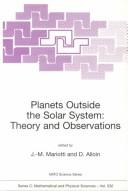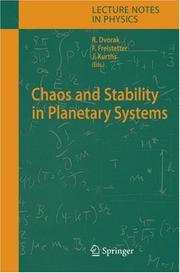| Listing 1 - 8 of 8 |
Sort by
|
Book
ISBN: 9783642093289 Year: 2010 Publisher: Berlin : Chichester : Springer Praxis,
Abstract | Keywords | Export | Availability | Bookmark
 Loading...
Loading...Choose an application
- Reference Manager
- EndNote
- RefWorks (Direct export to RefWorks)
Book
ISBN: 9780521139380 9780521191838 0521139384 0521191831 Year: 2010 Publisher: Cambridge: Cambridge university press,
Abstract | Keywords | Export | Availability | Bookmark
 Loading...
Loading...Choose an application
- Reference Manager
- EndNote
- RefWorks (Direct export to RefWorks)
Book
ISBN: 9789048186877 9789048186860 Year: 2010 Volume: 366 Publisher: Dordrecht Springer Netherlands Imprint Springer
Abstract | Keywords | Export | Availability | Bookmark
 Loading...
Loading...Choose an application
- Reference Manager
- EndNote
- RefWorks (Direct export to RefWorks)
The discovery of extrasolar planets over the past decade has had major impacts on our understanding of the formation and dynamical evolution of planetary systems. There are features and characteristics unseen in our solar system and unexplainable by the current theories of planet formation and dynamics. Among these new surprises is the discovery of planets in binary and multiple-star systems. The discovery of such "binary-planetary" systems has confronted astrodynamicists with many new challenges, and has led them to re-examine the theories of planet formation and dynamics. Among these challenges are: How are planets formed in binary star systems? What would be the notion of habitability in such systems? Under what conditions can binary star systems have habitable planets? How will volatiles necessary for life appear on such planets? This volume seeks to gather the current research in the area of planets in binary and multistar systems and to familiarize readers with its associated theoretical and observational challenges.
Extrasolar planets --- Double stars --- Exoplanètes --- Etoiles doubles --- Exoplanètes --- EPUB-LIV-FT LIVPHYSI SPRINGER-B
Book
ISBN: 9781036403539 Year: 2024 Publisher: Newcastle upon Tyne : Cambridge Scholars Publishing,
Abstract | Keywords | Export | Availability | Bookmark
 Loading...
Loading...Choose an application
- Reference Manager
- EndNote
- RefWorks (Direct export to RefWorks)
This book takes its readers on an Earthling’s tour through the Solar System. Beginning with an introductory survey of what can be seen in the sky, it describes what scientists have learned about the Earth and Moon, inner rocky planets, dominant gas giants, outer ice giants, moons, asteroids, comets, and other pieces of “cosmic debris” that all orbit around our home star – the Sun. It also considers the rapidly increasing number of planets known to be orbiting stars well beyond the Sun’s domain. Informed by the latest space missions, the book provides students, educators, and enthusiasts with an accessible guide to our home planetary system, its possible origin story, and its cosmic context as a wellspring of life.
Planets. --- Extrasolar planets. --- Life on other planets. --- Système solaire. --- Planètes. --- Exoplanètes. --- Vie extraterrestre. --- Solar system.
Book
ISBN: 9781108419772 9781108304160 1108419771 Year: 2018 Publisher: Cambridge: Cambridge university press,
Abstract | Keywords | Export | Availability | Bookmark
 Loading...
Loading...Choose an application
- Reference Manager
- EndNote
- RefWorks (Direct export to RefWorks)
With the discovery of planets beyond our solar system 25 years ago, exoplanet research has expanded dramatically, with new state-of-the-art ground-based and space-based missions dedicated to their discovery and characterisation. With more than 3,500 exoplanets now known, the complexity of the discovery techniques, observations and physical characterisation have grown exponentially. This Handbook ties all these avenues of research together across a broad range of exoplanet science. Planet formation, exoplanet interiors and atmospheres, and habitability are discussed, providing in-depth coverage of our knowledge to date. Comprehensively updated from the first edition, it includes instrumental and observational developments, in-depth treatment of the new Kepler mission results and hot Jupiter atmospheric studies, and major updates on models of exoplanet formation. With extensive references to the research literature and appendices covering all individual exoplanet discoveries, it is a valuable reference to this exciting field for both incoming and established researchers.
Extrasolar planets --- Exoplanètes --- Système solaire --- Etude et enseignement (supérieur) --- Solar system. --- Exoplanètes --- Système solaire --- Étude et enseignement (supérieur)
Book
ISBN: 9781107145382 1107145384 Year: 2019 Publisher: Cambridge: Cambridge university press,
Abstract | Keywords | Export | Availability | Bookmark
 Loading...
Loading...Choose an application
- Reference Manager
- EndNote
- RefWorks (Direct export to RefWorks)
Extrasolar planets --- Astronomy --- Geology --- Planetary geographic information systems --- Remote sensing --- Research --- Exoplanètes --- Astrologie --- Planetary geographic information systems. --- Remote sensing. --- Télédétection. --- Research. --- Recherche. --- Extrasolar planets - Remote sensing --- Extrasolar planets - Research --- Astronomy - Research --- Geology - Research --- Exoplanètes --- Télédétection.

ISBN: 0792357086 0792357094 9401146233 Year: 1999 Volume: 532
Abstract | Keywords | Export | Availability | Bookmark
 Loading...
Loading...Choose an application
- Reference Manager
- EndNote
- RefWorks (Direct export to RefWorks)
The question of the existence of other worlds and other living beings has been present in the human quest for knowledge since as far as Epicurus. For centuries this question belonged to the fields of philosophy and theology. The theoretical problem of the formation of the Solar System, and hence of other planetary systems, was tackled only during the 18th century, while the first observational attempts for a detection started less than one hundred years ago. Direct observation of an extra-solar planetary system is an extraordinarily difficult problem: extra-solar planets are at huge distances, are incredibly faint and are overwhelmed by the bright light of their own stars. With virtually no observational insight to test their models, theoreticians have remained for decades in a difficult position to make substantial progress. Yet, the field of stellar formation has provided since the 1980s both the the oretical and observational evidences for the formation of discs at the stage of star birth and for debris materials orbiting the very young stellar systems. It was tempting to consider that these left-overs might indeed later agglomerate into planetary systems more or less similar to ours. Then came observational evidences for planets outside the Solar System.
Astronomy & Astrophysics --- Physical Sciences & Mathematics --- Astrophysics --- Extrasolar planets --- Planets --- Congresses --- Planetology. --- Observations, Astronomical. --- Astronomy—Observations. --- Biochemistry. --- Astrophysics. --- Astronomy, Observations and Techniques. --- Biochemistry, general. --- Astrophysics and Astroparticles. --- Astronomical physics --- Astronomy --- Cosmic physics --- Physics --- Biological chemistry --- Chemical composition of organisms --- Organisms --- Physiological chemistry --- Biology --- Chemistry --- Medical sciences --- Astronomical observations --- Observations, Astronomical --- Planetary sciences --- Planetology --- Composition --- Extrasolar planets. --- Exoplanètes --- Exoplanètes

ISBN: 9783540282082 3540282084 3540345566 Year: 2005 Publisher: Berlin, Heidelberg : Springer Berlin Heidelberg : Imprint: Springer,
Abstract | Keywords | Export | Availability | Bookmark
 Loading...
Loading...Choose an application
- Reference Manager
- EndNote
- RefWorks (Direct export to RefWorks)
This book is intended as an introduction to the field of planetary systems at the postgraduate level. It consists of four extensive lectures on Hamiltonian dynamics, celestial mechanics, the structure of extrasolar planetary systems and the formation of planets. As such, this volume is particularly suitable for those who need to understand the substantial connections between these different topics.
Celestial mechanics. --- Planets --- Extrasolar planets. --- Mécanique céleste --- Planètes --- Exoplanètes --- Orbits. --- Orbites --- Planetary systems. --- Physics. --- Astronomy, Astrophysics and Cosmology. --- Complexity. --- Math. Applications in Geosciences. --- Geophysics/Geodesy. --- Astronomy - General --- Astrophysics --- Astronomy & Astrophysics --- Physical Sciences & Mathematics --- Planetary orbits --- Systems, Planetary --- Gravitational astronomy --- Mechanics, Celestial --- Earth sciences. --- Geophysics. --- Planetology. --- Astronomy. --- Astrophysics. --- Cosmology. --- Statistical physics. --- Dynamical systems. --- Astrophysics and Astroparticles. --- Statistical Physics, Dynamical Systems and Complexity. --- Earth Sciences, general. --- Geography. --- Physical geography. --- Complex Systems. --- Planetary sciences --- Planetology --- Geography --- Cosmography --- Earth sciences --- World history --- Geological physics --- Terrestrial physics --- Physics --- Geosciences --- Environmental sciences --- Physical sciences --- Dynamical systems --- Kinetics --- Mathematics --- Mechanics, Analytic --- Force and energy --- Mechanics --- Statics --- Mathematical statistics --- Astronomical physics --- Astronomy --- Cosmic physics --- Statistical methods --- Planetary science. --- Dynamics.
| Listing 1 - 8 of 8 |
Sort by
|

 Search
Search Feedback
Feedback About UniCat
About UniCat  Help
Help News
News